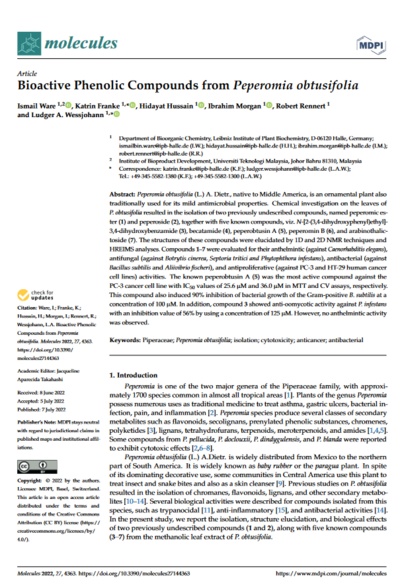Tracking down secondary metabolites of the baby rubber plant.
Peperomia are popular and widespread ornamental plants from the pepper family. The genus is very rich in species and is mainly found in Central and South America, where it is also used as a medicinal plant to treat insect bites, snake bites and for skin cleansing.
IPB chemists have recently analyzed in detail the secondary metabolites of the species Peperomia obtusifolia, also known as baby rubber plant. They were able to isolate two previously unknown and five already described natural compounds. Using 1D and 2D NMR spectroscopy, the research team deciphered the structures of the two unknown metabolites and named them peperomic ester and peperoside. Four of the already known constituents had previously only been found in related Peperomia species and could now also be confirmed as constituents of P. obtusifolia. All seven isolated compounds were tested for their biological activity against nematodes, fungi, bacteria, and cancer cells - with the result that the compound peperobtusin A showed an antibacterial effect against Bacillus subtilis and an antiproliferative and cytotoxic effect on cells of the prostrate cancer cell line PC-3. Another substance called N-[2-(3,4-dihydroxyphenyl)ethyl]-3,4-dihydroxybenzamide exhibited weak activity against the oomycete Phytophtera infestans.
Although the Halle scientists found little activity of peperoside and related compounds, they conclude by noting that similar phenethylamides exhibit taste and neuroactive properties. Consequently, the isolated compounds could possibly be non-toxic and therefore suitable for studies regarding these properties with animal or human subjects.
Original publication: Ware, I.; Franke, K.; Hussain, H.; Morgan, I.; Rennert, R.; Wessjohann, L.A. Bioactive Phenolic Compounds from Peperomia obtusifolia. Molecules 2022, 27, 4363. https://doi.org/10.3390/molecules27144363


